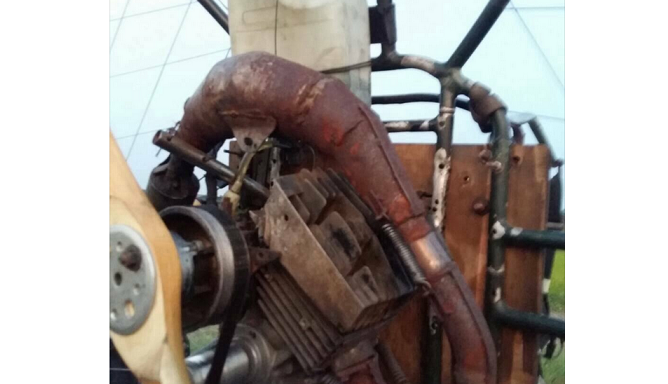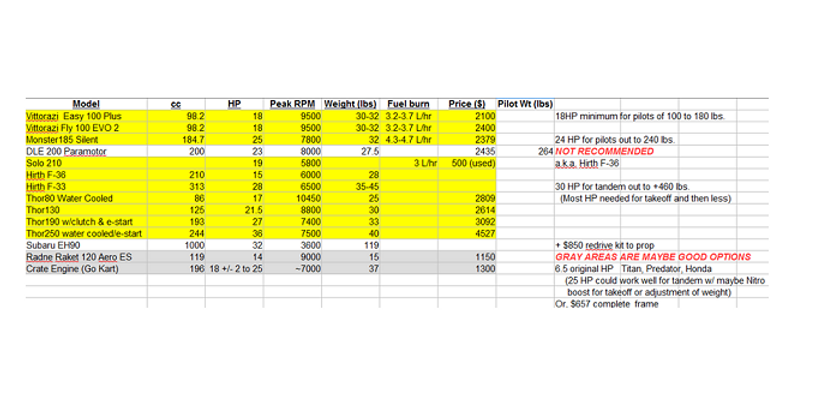
DIY PARAMOTOR PAGE
That's why Dad named you Joe Dirt instead of Nunamaker!
(1/15/18) Here, will be posted some of Stan's notes and commentary for others.
Generally, people build their own PPG for a couple reasons: 1) Budget; 2) Desiring intimacy with the aircraft; 3) Business interests in making and selling their own aircraft.
Generally, you have options on building things from scratch in regard to the frame. Wings, harness, and engines nobody tends to make due to greater complexity, cost, and expertise required. So, frames and undercarriage are where most the innovation and public participation occurs. Wings and engines tend to advance more slowly.
What Stan can tell you from his own experience in DIY research is this:
Do your homework first. Don't buy anything. Fly first. Talk to instructors, and other pilots. If you're looking to save cost, usually you can find a nice, used aircraft all ready to fly or even assemble new gear to save money. DIY will usually cost you a bit more. It can vary. If you make your own frame and acquire a good, used engine, then total costs can work out less than new but usually around the same or more than just buying a good, used aircraft. Economically, there's really no reason to DIY unless, like Stan, you enjoy exploring for areas of improvement and are looking to create a new product or business direction for your shop.
Stan's airframe designs and some engine things are kept secret at this point, but we'll start this page off by sharing some engine data and thoughts for any DIY people out there.
Prices
New wings will set you back anywhere from $2000 to $5000, depending upon size (and there is some cool custom advertising available -- adhesive letters, paint on letters, sewn on or you might just want to banner tow). Sometimes you can find a used paraglider in the $500 to $1000 range, but be sure to have it inspected first (fabric porosity, lines, etc.). Also, consult your flight instructor on the best wing for you and your weight, flying style, intentions, and find something you can grow into.
Offshelf frames (backpack PPG) run anywhere from $550 to $2000 or more new. Used are sometimes found. We know of many great vendors. There is also the old Skybolt DIY frame, which is great, particularly with modern safety modifications. Still, a frame will cost you around $200 to $300 in materials and some time at the very least. Stan's method for airframes starts first with CAD and FEA analysis. Then, physical mockup -- cardboard tube and hot melt glue, cut board, wood, foam....for a 3D layout and fit checking. From there, it depends upon material selection. Steel to the cage? Aluminum? Electrical conduit? Fiberglass, Carbon Fiber, Kevlar? For example, though carbon fiber is all the rage, fiberglass can also work, cost less, and be better in vibration. Welding aluminum and steel generally is easier and less mess, but lacks all the flexibility in geometry of composites. One way we explore on frame construct is just composite wrapping of our cardboard tube mockups (which is aided by Peel Ply for achieving smooth surfaces). With composites, you have to be very careful on cure, mixing, temperature, bubbles, and quality -- especially in regard to material thickness. In our Academic Links, you will find free FAA Aviation Maintenance Technician manuals (General and Airframe in particular) which cover standard aircraft construction methods -- how much fiberglass thickness to layer at joints, etc.
Harnesses run anywhere from $500 to $1000 new.
Propeller ($200 to $500 new or more).
Fuel tank, netting, accessories....they all add up.
And then, there is the engine!
ENGINES
The source of your future vulgarities screamed!
If you are really lucky and take good care of it in maintenance and operation, a $2400 to $5000 engine should last you around 300 to 500 hours Time Between Overhaul (TBO). Emphasis upon SHOULD there.
Things you will do to ruin it early? Insufficient warm-up. Heavy prop loading. Prop strikes. Overheating.
Depending upon the engine you pick, spare parts either no longer exist, vendor customer service is poor, engine and user data is lacking, or you will find engines of great spares availability and wide user groups (such as Vittorazi and Black Devil).
(More on engines and links will be posted here).
When looking at the prices, at first the DIY builder will be tempted to go with the cheapest. Here, your first thoughts are:
Hot-rodded weed whacker engines.
Custom hot-rodded chain saw engines.
Go cart engines.
RC airplane engines.
Electric systems -- EDF, motors, rotors, etc.
Weed whackers:
Yes...possible. Generally too small in materials (section modulus), too weak in horsepower, and considerable mods to make....with not much out there. Tending to cost more. More likely to break down.
Chain saw / Hot Saws:
These are excellent options -- Stihl, Kohler, Echo, etc. You'll need to machine or acquire spindles and redrive plus propeller hub, in addition to mods for more horsepower. And, some of these hot saw competition guys charge more than the aviation industry!
Go Cart engines/ Mini bikes:
These are some really good and cheap little engines -- Predator 212, Honda, Titan. They also have ample proving in the race cart circuit. Nice engine mods -- pistons, flywheel, heads, porting, exhaust, carbs, valve springs. Lovely engine work! However, you'll need to spend on the redrive (gearing / belt system to the propeller), and be sure the power curve is where it should be. You'll spend around $1,200 here whether DIY on the engine or purchase offshelf, plus machining and other mods. And, the engines are still a bit heavier per horsepower than established aircraft engines.
RC airplane engines:
Among Stan's favorites are the DLE 200. People are even putting these to paramotors now. Stan, however, passed on inclusion of these in any design at this time due to: a) Made in China machining quality maybe needing improvement; b) Propeller loading of manned flight is much more than for drones. They are cute little engines and you can get one for $1,100 but Stan would be surprised if you are not doing major overhauls on them every 25 to 50 hours. That is not to say they have no potential. Stan loves the little 4 cylinders to them. He just thinks they are better in twin, tri, and quad propeller formats for ultralight flight. Asking them to fly in PPG is a bit like asking a 1970's Ford Pinto engine to pull a diesel big rig's trailer uphill. You are going to overheat and break them. There isn't enough user data back from the field. Overhaul parts costs are about comparable to the costly aviation engines. Therefore, not advisable at this time without further information.
Electric and Hybrid Electric options:
Yes, this is the future of unmanned and manned flight. It is one of Stan's biggest flight research areas. Generally, the power curve and ease of operation is so much better than combustion.
However, present batteries will only get you a few minutes of flight to less than an hour at best. Stay tuned, though. Battery and fuel cell tech for double to quadruple capacity are in the works near-term due to the drone industry's demand. Many are the ways. Generally, you will spend more cost and acquire more weight with less performance and duration in this zone. There is some excellent R&D ongoing in the world and right here on the matter, though. Sorry, we cannot help you or talk about much in this area....trade secret, existing deals, etc. But, we are working on things.
If you are a new PPG pilot starting out, Stan recommends this:
Don't buy anything.
Don't build anything.
Don't be a student pilot and test pilot at the same time.
Start your flight training. Explore your rental and purchase options with your instructor and other pilots. Often, you can find used gear from quitting students, or among scrap laying around at your flight school. Focus on your flying and make modifications while having DIY fun from there. Tap the wisdom of experienced others first.
If you just have to build something, start first with a frame like Skybolt.
Keep in mind this aircraft mechanic perspective: "If it flew in, dammit it will fly out!" (So much easier it is to upkeep a working airplane....and often a struggle with just that....than it is to build one from scratch or take on a restoration project.). Not to discourage building and the long tradition of DIY in aviation, but do you want to fly now, or wrench on it over time, or potentially never complete it? The General Aviation and FAR 103 world are filled with kits and other build projects than never left earth. You can find them for sale cheap on EBay! Don't let your bird become what we call a "hangar queen".
Remember, 'tis better to overhaul a cheap, old, long-proven aviation engine than to try building a new one. You might say, "Bah! It's a parachute! I don't need an engine! I'm a paraglider pilot!" (and PPG engines do fail all the time)....but, still, it ruins your outing at the very least. It will have you landed and having to hike out of remote areas in the best of cases. Are you prepared to be impaled by tree branches? Drown in even just 18 inches of shallow water? Die of injuries and exposure while waiting for help? Be eaten and with the only remains left that your family can bury are nothing but scattered bones and bear crap? Yes, we have no need for engines but skimping on and mistreatment of engines will generally cost you more in the end.
Below is a table of some common engines -- price, horsepower, weight, and notes which can help your selection.
We are working on some engine accessories and mods here for improved reliability.
Stan also recommends the following maintenance practices from certificated, heavier aircraft:
25, 50, 100 hour, and Annual inspection & servicing. Being two-strokes, you cannot go wrong to cut these times in half or more for increased maintenance intervals.
Routine compression checks.
Oil & filter change
Oil analysis baseline at start and every 25 hours of flight. At $100, that costs you $4 per flight hour but is valuable on prediction of failures, and you don't have to do it every 25 hours. Please see our Engine Diagnostics Page for other options.
Warm-up period before high RPM
Temperature monitoring and avoiding overheating inflight.
Installation of temperature measurement sensors (Cylinder head and EGT) and a Hobbs meter (time meter) or logging of all run-time and flight hours.
Aircraft maintenance logbooks on airframe & engine, just like with bigger aircraft.

